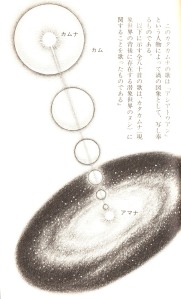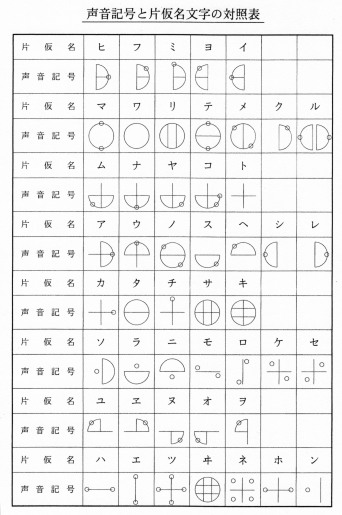
In an earlier post entitled, KATAKAMUNA ANCIENT CIVILIZATION, we mentioned a book written by Fukano:
Fukano Kazuyuki, 超科学書「カタカムナ」の謎, Chogakusho Katakamuna no Nazo, Super-Science Katakamuna Mystery, Kosaido Books, 1993
We have been studying the book and we present this summary of the main points of the super-physics as we understand them. While most of us think of Katakamuna as an ancient writing system of Hinomoto, author Fukano has interpreted the verses as descriptions of the physics of Universe. What is remarkable is that such an old physics could be so like modern physics. Put another way, our modern physics may be approaching what was known to ancient people! Indeed, Katakamuna’s Latent and Physical Worlds may correspond to David Bohm’s Implicate and Explicate Orders.
Katakamuna Universe
What is Katakamuna? Katakamuna is the root of all in Universe. Ama is Universe and includes Time, Space, and Everything. The Space aspect of Universe is Ame. Time and Space together are Ma. Mari is the fundamental quantum which is always spinning ‘up’ and ‘down’ and orbiting around Ma. Through the movement of Mari, Amashigenryou is possible and it, itself, is revolving and condensing. Thus Amashigenryou creates the two aspects of Universe: Kamuna, The Latent World, and then Amana, the Phenomenal World. The Phenomenal World is created through the combined energies of Kamuna and Amana. Kamu is infinite energy of Universe.
Amashigenryou is the fundamental building block of Universe created by the motion of Mari. Mari are quanta of the ultimate differentiated “particles” and their movement creates all the quanta of Amashigenryou as well as the Latent World and the Physical World.
Kamuna and Amana Worlds
Worlds
Kamuna Amana
Latent Physical
Unseen Seen
Infinite Limited
Hidden Present
Kamuna is the Latent World. We may call it the Unseen World, Infinite World, Hidden World. It is the world of pure nonphysical energy. Kamuna is mugen-sekai, Infinite world. 無限 mugen, limitless.
Amana is the world we know as the Physical World. Also it may be called the Seen World, Limited World, Present World, Phenomenal World. It is our familiar world of matter. Amana is gensho-sekai, Phenomenal World, the world we live in. 現象 gensho, phenomenal. 現 gen, present; sho, vision.
Note that author Fukano calls Kamuna and Amana “worlds.” Perhaps we can think of them as dimensions, or as Bohm’s orders. Amana comes from Kamuna. The Physical World comes from the Latent/Hidden World. The integrated chikara power of both creates Universe.

Kamuna giving rise to Amana
Amashigenryou アマ 始 元 量
Amashigenryou is the elementary quantum of Universe, the spiraling of the microscopic particles of Universe. Everything is a converted version of Amashigenryou. アマama; 始 shi, beginning; 元 gen, origin; 量 ryou, quantum
Amashigenryou always keeps revolving and rotating, repeating, overlapping, condensing, creating first Kamuna and then Amana. Then the chikara powers of Kamuna and Amana combine. The combined power creates ‘ryushi’, seen particles, which are the ‘gensho’ phenomenal particles, and stabilizes the Seen World. The Seen World then has matter, substance, seimei living things and objects.
Kamu and Mari
Kamu is infinite energy. There is infinite energy Kamu in Universe. Universe is made of physical matter as well as the Latent, i.e., the physical and the nonphysical. Amashigenryou is generated in the world of Infinite Kamu, from ‘the infinite derivation of Mari.’
Mari. The ultimate differentiated quantum of Universe is called Mari. It is the source of Amashigenryou and other quanta. Mari is a spherical particle. The size of Mari is in the order of 10^-80 cm. Mari is not a perfect sphere; it has a dent in its surface. Without this dent, rotation around an axis would not be possible. Mari simultaneously rotates clockwise and counter-clockwise, creating yin-yang polarities.
Latent World
In the Latent World, Mari マリ are quanta of the itsu-tsumi (5 tsumi) : toki, tokoro, ikatsumi, makumi, karami.
toki is quantum of time
tokoro is quantum of place
ikatsumi is quantum of electricity
makumi is quantum of magnetism
karami is quantum of gravity
The mari of ‘toki’ is Amashigenryou, the quantum of time in the Latent World. The mari of ‘tokoro’ is アメAme, the quantum of space in the Latent World.
The last three tsumi (the quanta of electricity, magnetism, and gravity) are together called mitsugo in the Latent World. They create the living and non-living ‘mokoro’ with forces of electricity, magnetism, and gravity.
Mokoro in the Latent World consist of one each of the three mitsugo forces. The ‘object mokoro’ of nonliving things is a mitsugo with one axis that is repeatedly living and dying. The ‘seimei mokoro’ of living things has eight axes, instead of only one. All eight axes are living and dying repeatedly and all eight are rotating.
Physical World
The Physical World of Time, Space, and Everything is derived from, or created by, the Latent World through the action of the Mari.
Mari of ‘toki’ makes Time.
Mari of ‘tokoro’ makes Space.
The other Mari together make Everything: the living and nonliving things of the Physical World.
Editor’s Note: The details in this last part about the relationships between Latent and Physical Worlds come from the small table, very near the end, on page 225 of the book, while the beginning of this post comes from an earlier part of the book. We wish to express our appreciation to E.K. for assistance with the difficult translation.
Concluding Remarks
The physics of Fukano is not easy to understand, and we do not claim to have interpreted it correctly. However, we feel it is important to call it to your attention so that you can delve more deeply into its study. We continue with Parts 2 and 3.
Revised 2017.04.12
*
 Latent and Phenomenal Worlds
Latent and Phenomenal Worlds


 mmon circle is the Yatanokakami symbol, the one on top which occurs in 71 out of 80 verses. The next is called Futomani which appears in 7, and the bottom circle is the Mikumari, in 2 verses.
mmon circle is the Yatanokakami symbol, the one on top which occurs in 71 out of 80 verses. The next is called Futomani which appears in 7, and the bottom circle is the Mikumari, in 2 verses.






You must be logged in to post a comment.